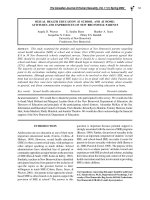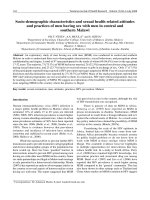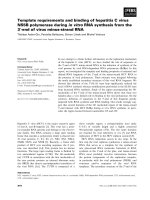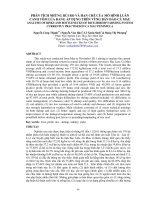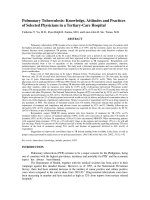Knowledge, attitudes and misconceptions of Italian healthcare professionals regarding fever management in children
Bạn đang xem bản rút gọn của tài liệu. Xem và tải ngay bản đầy đủ của tài liệu tại đây (639.92 KB, 6 trang )
Chiappini et al. BMC Pediatrics (2018) 18:194
/>
RESEARCH ARTICLE
Open Access
Knowledge, attitudes and misconceptions
of Italian healthcare professionals regarding
fever management in children
Elena Chiappini1*, Antonina Marta Cangelosi1, Paolo Becherucci2, Monica Pierattelli2, Luisa Galli1
and Maurizio de Martino1
Abstract
Background: Fever phobia is still a major issue in paediatrics. We report knowledge of a sample of Italian
paediatricians performed six years after the release of the Italian guidelines for the management of fever in
children (IFG).
Methods: A questionnaire, developed following the IFG recommendations and previously administered to 300
paediatricians in 2012, was proposed to all the paediatricians attending the 2015 National Congress of Practice
Paediatrics, held in Florence, Italy. Changes in answers over time were analyzed.
Results: 70.2% (562/800) paediatricians returned the questionnaire. The recommended site and device for body
temperature measurement in children > 1 year was correctly chosen by 89.3% of participants (vs. 80.7% of 2012
participants; P < 0.001), but with children aged less than 1 year the correct answer was selected only by the 50.3%
(vs. 39.3% of 2012 participants: P < 0.001).
Use of physical methods was still incorrectly recommended by 51.6% of paediatricians (vs. 63.6% in 2012; P < 0.
001). Use of antipyretics according to discomfort was adopted only by 38.2% of participants, while 12.2% of them
recommended alternate use of antipyretics. These proportions were substantially stable since 2012 (45 and 11%
respectively), rectal administration of antipyretics only in case of vomiting was correctly recommended by 86.8%
of paediatricians vs. 74.7% in 2012 (P < 0.001).
Conclusion: Improvements in some pediatricians’ misconceptions were observed over time. However, some incorrect
habits persist. Further studies are needed to better understand the “weak points” of the communication between
Scientific Societies and paediatricians in order to impact everyday clinical practice.
Keywords: Fever, Children, Antipyretics, Thermometer, Paracetamol, Ibuprofen
Background
Since the 1980’s, when Barton Schmitt coined the term
“fever phobia” [1], several studies have been published in
this regard, reporting its presence both among healthcare professionals and parents/tutors, in Western countries as well as in limited resource settings [2, 3]. Despite
the dissemination of several international guidelines [4,
5], poor knowledge about the correct use of antipyretics
still persists among paediatricians. The results of the
most recent surveys performed in Italy and in other
European countries show improvements, but also the
potential for further optimization [2, 6]. The present
study investigated changes in knowledge/misconceptions
over time by surveying a large sample of paediatricians,
comparing results with those obtained in a previous
similar national survey [6].
Methods
Study design
* Correspondence:
1
Department of Health Sciences, Anna Meyer Children’s University Hospital,
University of Florence, Viale Pieraccini, 24, 50100 Florence, Italy
Full list of author information is available at the end of the article
A survey was conducted including paediatricians attending the National Congress of Practice Paediatrics, held
in Florence in November 2015. All the paediatricians
© The Author(s). 2018 Open Access This article is distributed under the terms of the Creative Commons Attribution 4.0
International License ( which permits unrestricted use, distribution, and
reproduction in any medium, provided you give appropriate credit to the original author(s) and the source, provide a link to
the Creative Commons license, and indicate if changes were made. The Creative Commons Public Domain Dedication waiver
( applies to the data made available in this article, unless otherwise stated.
Chiappini et al. BMC Pediatrics (2018) 18:194
Page 2 of 6
Table 1 Temperature monitoring site/method used by paediatricians participating in the 2012 and 2015 surveys and type of
thermometer recommended
2012 n (%; 95% CI) n = 300
2015 n (%; 95% CI) n = 562
P
118 (39.3; 33.8–44.9)
283 (50.4; 46.2–54.5)
0.001
Children < 1 year of age
Axillary*
Rectal
124 (41.3; 35.8–46.9)
192 (34.2; 30.2–38.1)
0.020
Groin crease
38 (12.7; 8.9–16.4)
71 (12.6; 9.9–15.4)
0.980
Oral
0 (0.0; 0.0–0.0)
1 (0.2; 0.0–0.5)
0.950
Auricular
18 (6.1; 3.3–8.7)
7 (1.2; 0.3–2.2)
< 0.0001
Forehead
2 (0.6; 0.0–1.6)
8 (1.4; 0.4–2.4)
< 0.0001
Children > 1 year of age
Axillary*
242 (80.7; 76.2–85.1)
502 (89.3; 86.8–91.9)
0.0003
Rectal
9 (3.0; 1.1–4.9)
20 (3.6; 2.0–5.1)
0.660
Groin crease
15 (5.0; 2.5–7.5)
24 (4.3; 2.6–5.9)
0.630
Oral
2 (0.7; 0.0–1.6)
1 (0.2; 0.0–0.5)
0.240
Auricular
29 (9.6; 6.3–13.0)
6 (1.1; 0.2–1.9)
< 0.0001
Forehead
3 (1.0; 0.0–2.1)
10 (1.8; 0.7–2.9)
0.370
203 (67.7; 62.4–73.0)
385 (68.5; 64.7–72.3)
0.430
Type of recommended thermometer
Digital*
Auricular
15 (5.0; 2.5–7.5)
9 (1.6; 0.6–2.6)
0.003
Other**
32 (10.6; 7.2–14.2)
168 (29.8; 26.1–33.7)
< 0.0001
Note: * right answer according to the Guidelines of the Italian Paediatric Society
**mercury, skin infrared, plastic streap placed forehead, dummy-pacifier style thermometers
Table 2 Use of physical methods and antipyretics among paediatricians participating in the 2012 and 2015 surveys
First choice drug
2012 n (%)
2015 n (%)
P
Paracetamol*
295 (98.3; 96.1–99.3)
546 (97.1; 95.4–98.4)
0.656
Ibuprofen*
4 (1.3; 0.5–3.4)
12 (2.1;1.2–3.7)
0.40
Other
1 (0.3; 0.0–1.8)
4 (0.7; 0.3–1.8)
0.48
Second choice drug
Paracetamol*
19 (6.3; 4.1–9.7;)
61 (10.8; 8.5–13.7)
0.03
Ibuprofen*
276 (92.0; 88.4–94.6)
495 (88.1; 85.1–90-5)
0.04
Acetylsalicilic acid
2 (0.7; 0.2–2.4)
0 (0.0; 0.0–0.0)
0.12
Other
3 (1.0;0.3–2.9)
6 (1.1; 0.5–2.3)
0.92
Oral
249 (83.0; 78.3–86-8)
517 (92.0; 89.4–94.0)
< 0.0001
Rectal
51 (17.0;13.2–21.7)
45 (8.0;6.0–10.5)
< 0.0001
34 (11.3; 8.2–15.4)
69 (12.3; 9.8–15.2)
0.40
Together with antipyretic drug
29 (9.7; 6.8–13.5)
36 (6.4; 4.7–8.7)
0.08
Before the antipyretic drug
9 (3.0; 1.6–5.6)
14 (2.3; 14.5–41.4)
0.66
If fever persists
153 (51.0; 45.4–56.6)
242 (43.1; 39.0–47.2)
0.15
Never*
109 (36.3; 31.3–41.9)
270 (48.0; 43.9–52.2)
< 0.0001
Choice of administration of paracetamol
Alternating use
Yes
Use of physical methods
Note:* right answer according to the Guidelines of the Italian Paediatric Society recommendation
Chiappini et al. BMC Pediatrics (2018) 18:194
attending the conference received an anonymous, standardized and self-administered paper-based questionnaire. They were requested to participate to the survey
by returning the filled questionnaire to the conference
registration desk. Results were entered into an electronic
database, analyzed and compared with those obtained
from a previous similar survey, performed in 2012, at
the 12th National Congress of the Italian Society of
Paediatric Infectious Diseases and based on the same
questionnaire (Appendix 1) [6].
Questionnaire
The questionnaire was developed on the basis of previous
similar surveys [6, 7], and in consideration of the IFG
recommendations [4]. The questionnaire consisted in
multiple choice questions, as previously described [6].
Briefly, the main topics included: methods and devices
recommended for the measurement of body temperature,
knowledge regarding the use of physical methods and
antipyretics.
Statistical analysis
The results were expressed as absolute numbers, percentages and 95% confidence intervals (95% CIs) were
calculated. The χ2 or the Fischer’s exact test (2 grades of
freedom) were used in order to calculate differences
among responses between the years 2012 and 2015.
SPSS software package was used and p value < 0.05 was
considered as statistically significant.
The study was not commercially sponsored.
Fig. 1 Change in Italian paediatricians’ knowledge over time
Page 3 of 6
Results
The questionnaire was returned by 562/800 (70.%) of
participants; the majority (91.9%; 517/562) were primary
care paediatricians; 16 (2.8%) were hospital paediatricians, and 29 (5.1%) residents/other; 393 (69.9%) participants declared to be aware of IFG.
Methods for body temperature measurement
In children under one year of age, axillary site was correctly chosen by an increased number of paediatricians
over time: 50.3% in 2015 vs. 39.3% in 2012 (p < 0.0001).
However, the rectal measurement, which was discouraged by the IFG because considered invasive, was still
commonly adopted: the proportion of participants who
recommended rectal measurement in children under
one year of age was 41.3% in 2012 and 34.2% in 2015
(p = 0.002) (Table 1).
In children > 1 year of age, a correct answer indicating
axilla as the preferred site for temperature measurement
was provided by 89.3% of paediatricians vs 80.7% in the
2012 survey (p = 0.0003).
Considering the type of thermometer recommended, the
digital one was the most widely recommended (68.5%);
while the use of auricular thermometer decreased overtime
and was only 1.6% in 2015 vs 5.0% in 2012 (P = 0.003)
(Table 1).
Use of physical methods and antipyretics
Wet bandages, ice bags and other physical methods (discouraged by IFG) were never recommended by 48.0% of
paediatricians in 2015, with a significant increase from the
Chiappini et al. BMC Pediatrics (2018) 18:194
results reported in the 2012 survey (36.4%; P < 0.0001)
(Table 2).
The use of antipyretics according to the presence of discomfort, and not for a specific cut-off of body temperature,
was recommended only by 38.2% of paediatricians (vs.
45.3% in 2012).
Paracetamol was confirmed as the first choice antipyretic drug for 97% of paediatricians (Table 2).
None of the participants recommended acetylsalicylic
acid but, unfortunately, a small proportion of paediatricians recommended other drugs, besides paracetamol
and ibuprofen (including steroids and metamizole) with
an antipyretic purpose (Table 2).
Rectal administration only in case of vomiting was
correctly recommended by 86.8% of paediatricians in
2015 vs. 74.7% in 2012 (P < 0.0001).
The alternate use of paracetamol and ibuprofen was
recommended by 12.2% of paediatricians in 2015, similarly to 2012 (Table 2; Fig. 1).
Discussion
In the present study, changes in knowledge and misconceptions among paediatricians over time were evaluated.
Considering also results from our 2009 survey, which
included 480 Italian paediatricians [7], progressive
improvements in the amount of correct answers were
observed (Fig. 1). However, several incorrect habits, including use of physical methods, use of antipyretics not
focused on the presence of discomfort, alternate use of
antipyretics, and rectal misuse of these drugs are still
common.
Several previous studies investigated misconceptions
of paediatricians concerning the management of fever in
children. Italian pediatricians’ knowledge seems to be in
line, or slightly better, than those reported in other European countries in recent years. As an example, the use
of physical methods was recommended by 77% of paediatricians in Switzerland [8] and 74% of them [9] in
France; this proportion is higher than observed in our
study (about 50%). Alternate use of antipyretics was recommended by 65% of Swiss paediatricians [8] but only
by 11% of our participants.
The reasons behind the persistence of fever phobia over
time have been previously explored [2]. The lack of a strict
definition of the child’s discomfort is one major obstacle.
Moreover, the evaluation of the child’s discomfort is usually subjectively assessed by one caregiver, and it is influenced by his/her fever-phobia level, in a sort of “vicious
circle” [2]. Another issue is the quality of educational material provided by the Scientific Societies that has been
found to be often unclear [10]. Finally, paediatricians
should improve their ability to communicate with caregivers, not only in terms of time spent for the parents’
Page 4 of 6
education, but also in efforts toward an empathetical and
trustful connection with the caregiver [11].
Our study has several limitations. Our results may not
be generalized to all paediatricians in Italy, since those included represent approximatively 7% of the entire population of the Italian paediatricians [6]. The two surveys were
conducted during two different Conferences. Therefore,
the two populations of paediatricians may differ in some
characteristics. Personal data (i.e. age and residence) of
participants were not collected. Hence our results do not
provide information regarding possible differences according to the geographical provenience, age, or other variables. Moreover, adjustment for potential confounders
was not possible. It is well-known that self-reported behaviors can be misleading, since some participants might
not complete the survey as carefully as they would do in
real settings [6]. Participants could be more interested in
Table 3 Main recommendations by the Italian fever guidelines [4]
✓ Rectal measurement should not be used routinely in children
aged < 5 years because it is invasive and causes discomfort
(evidence
level III; strength of recommendation D).
✓ Oral measurement of body temperature should be avoided in
children (evidence level III; strength of recommendation D).
✓ Axillary measurement using a digital thermometer is recommended
in children aged < 4 weeks (evidence level III; strength of
recommendation B).
✓ In the hospital or ambulatory care setting, axillary measurement
using a digital thermometer or tympanic measurement using an
infrared thermometer is recommended in children aged ≥4 weeks
(evidence level II; strength of recommendation B).
✓ For measurements taken at home by parents/caregivers, axillary
measurement using a digital thermometer is recommended in all
children (evidence level II; strength of recommendation B).
✓ Use of a tympanic infrared thermometer is not recommended, as
this mode of measurement is prone to operator-related error.
✓ Use of antipyretics in children is recommended only when the
fever is associated with evident discomfort (eg, prolonged crying,
irritability, reduced activity, reduced appetite, disturbed sleep)
(evidence
level I; strength of recommendation B).
✓ Use of physical methods to reduce fever is not recommended
(evidence level I; strength of recommendation E).
✓ Paracetamol and ibuprofen are the only antipyretic drugs
recommended for use in children (evidence level I; strength of
recommendation A).
✓ Use of acetylsalicylic acid in children is not recommended because
of the risk of Reye’s syndrome (evidence level III; strength of
recommendation E).
✓ Because of their poor benefit– risk ratio, steroids should not be
used as antipyretics in children (evidence level III; strength of
recommendation E).
✓ Combined or alternating use of ibuprofen and paracetamol is not
recommended (evidence level VI; strength of recommendation D).
✓ Rectal administration of antipyretics should be considered only in
the presence of vomiting or other conditions that prevent oral
administration (evidence level I; strength of recommendation A).
Chiappini et al. BMC Pediatrics (2018) 18:194
fever management than non-responding paediatricians.
On the other hand, we were able to administer the same
questionnaire to large samples of Italian pediatricians,
from 2009 to 2015, exploring changes in the adherence to
the guideline’s recommendations over time and which
messages should be strengthened (Table 3).
Conclusion
Our study highlights improvements in the management
of the febrile child in Italy, but also detected the persistence of some incorrect habits. Several key messages of
the IFG must be further stressed. In particular, the recommendation regarding the use of antipyretics according to the child’s discomfort seems to be adopted only
by a minority of paediatricians. Similarly, recent literature reports suggest that improvements in educational
interventions are needed in many European countries
[2]. Our results may be of help for targeting educational
interventions and adherence to practices recommended
by the IFG. Further studies are needed in order to
understand “weak points” of the communication between Scientific Societies and pediatricians, as well as
between paediatricians and caregivers.
Appendix
Page 5 of 6
f ) “dummy”
g) I don’t suggest any particular thermometer
4. Above what temperature do you administer
antipyretics?
a)
b)
c)
d)
e)
f)
< 37 °C
37.5 °C
38 °C
38.5 °C
39 °C
not exist a temperature cut off, depend on patient
malaise
5. Which antipyretic drugs do you usually suggest to
use?
a)
b)
c)
d)
acetaminophen
ibuprofen
aspirin
other (metamizole, betamethasone)
6. When the temperature is not going down quickly,
do you believe it is useful to associate two or more antipyretic drugs?
Questionnaire
1. Where should body temperature be measured in children under one year?
a)
b)
c)
d)
e)
f)
the armpit
the rectum
groin crease
the mouth
the ear
on the forehead
2. Where should the body temperature be measured in
children over one year?
a)
b)
c)
d)
e)
f)
the armpit
the rectum
groin crease
the mouth
the ear
on the forehead
3. What kind of thermometer do you suggest to measure temperature?
a)
b)
c)
d)
e)
mercury-in-glass
electronic
auricular
skin infrared
plastic strip placed on forehead
a) yes
b) no
7. Do you suggest to use physical methods as sponging
or ice pack to reduce a child’s body temperature?
a) yes, with the antipyretic drug
b) yes, before the antipyretic drug
c) only if the temperature is not going down after the
antipyretic drug
d) no, never
8. When do you suggest to administer antipyretic drug
rectally?
a)
b)
c)
d)
it’s more useful
it’s more practical
because parents prefer this way
only in the presence of vomiting
Abbreviation
IFG: Italian Fever Guideline
Availability of data and materials
Data will not be shared online. Data are available on personal request to the
corresponding author.
Consent to publish
Not applicable.
Chiappini et al. BMC Pediatrics (2018) 18:194
Authors’ contributions
EC conceived the study, participated in the design and coordination, and
drafted the manuscript. MC and LG performed the statistical analyses and
drafted the manuscript. PB, MP and MdM participated in study design and
helped to draft and review the manuscript. All authors read and approved
the final manuscript.
Ethics approval and consent to participate
Ethics approval and consent to partecipate was not required for this study
according to the opinion to the Local Ethic Committee of the Anna Meyer
Hospital, Florence, Italy. We considered completion of the questionnaire as
consent to participate.
Competing interests
The authors declare that they have no competing interests.
Publisher’s Note
Springer Nature remains neutral with regard to jurisdictional claims in published
maps and institutional affiliations.
Author details
1
Department of Health Sciences, Anna Meyer Children’s University Hospital,
University of Florence, Viale Pieraccini, 24, 50100 Florence, Italy. 2Primary Care
Paediatrician, Florence, Italy.
Received: 29 April 2016 Accepted: 11 June 2018
References
1. Schmitt BD. Fever phobia: misconceptions of parents about fevers. Am J Dis
Child. 1980;134:176–81.
2. Crocetti M, Moghbeli N, Serwint J. Fever phobia revisited: have parental
misconceptions about fever changed in 20 years? Paediatrics. 2001;107:1241–6.
3. Bertille N, Purssell E, Corrard F, Chiappini E, Chalumeau M. Fever phobia 35
years later: did we fail? Acta Paediatr. 2016;105:9–10.
4. Chiappini E, Venturini E, Remaschi G, Principi N, Longhi R, Tovo PA, Becherucci
P, Bonsignori F, Esposito S, Festini F, Galli L, Lucchesi B, Mugelli A, Marseglia GL,
de Martino M. Italian pediatric society panel for the Management of Fever in
children. 2016 update of the Italian pediatric society guidelines for
Management of Fever in children. J Pediatr. 2017;180:177–83.
5. Fields E, Chard J, Murphy MS, Richardson M, Guideline Development Group
and Technical Team. Assessment and initial management of feverish illness
in children younger than 5 years: summary of updated NICE guidance. BMJ.
2013;f286:346.
6. Chiappini E, D’Elios S, Mazzantini R, Becherucci P, Pierattelli M, Galli L, de
Martino M. Adherence among Italian paediatricians to the Italian guidelines
for the management of fever in children: a cross sectional survey. BMC
Paediatr. 2013;13:210.
7. Chiappini E, Parretti A, Becherucci P, Pierattelli M, Bonsignori F, Galli L, de
Martino M. Parental and medical knowledge and management of fever in
Italian pre-school children. BMC Paediatr. 2012;12:97.
8. Lava SA, Simonetti GD, Ramelli GP, Tschumi S, Bianchetti MG. Symptomatic
management of fever by Swiss board-certified paediatricians: results from a
cross-sectional, web-based survey. Clin Ther. 2012;34:250–6.
9. Bertille N, Pons G, Khoshnood B, Fournier-Charrière EA. National Survey of
healthcare Professionals’ practices in France. PLoS One. 2015;10(11):e0143230.
10. Freda MC. The readability of American Academy of Pediatrics patient
education brochures. J Pediatr Health Care. 2005;19:151–6.
11. Sahm LJ, Kelly M, McCarthy S, O'Sullivan R, Shiely F, Romsing J. Knowledge,
attitudes and beliefs of parents regarding fever in children: a Danish
interview study. Acta Paediatr. 2016;105:69–73.
Page 6 of 6
